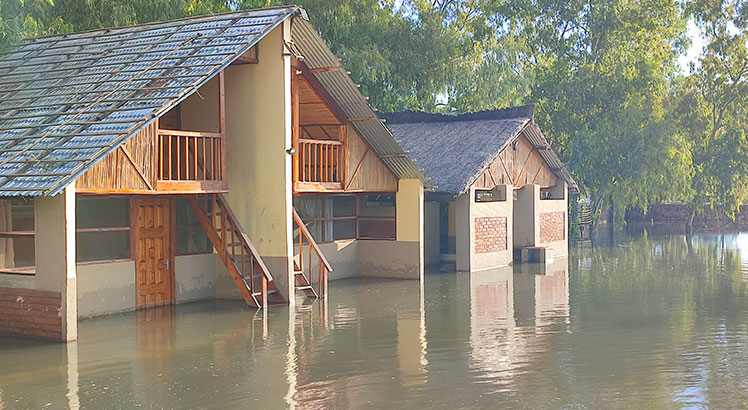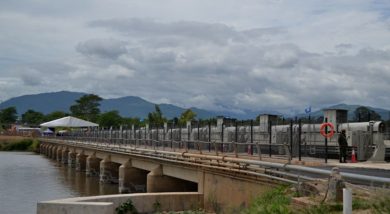Lake of stars’ darkest hour
From prolonged dry spells scorching crops to hitherto erratic rains flooding their homes, hundreds of residents along Lake Malawi shores are counting losses as climate-related disasters become more repeated and devastating.
In the past two months, William Saidi and Siga Layisoni of Mapira in Mangochi Town along the Shire River have changed homes twice since their house was swamped by floods from the sole outlet of Lake Malawi.
The couple is among about 3 090 people from 525 households displaced by the flooding resulting from the swelling lake, which has left beachside hotels, resorts and settlements in water.

Lake Malawi started rising in February when the Southern Region experienced a month-long dry spell caused by the El Nino weather pattern across southern Africa. However, heavy rains in the Northern Region and northwestern parts of Tanzania left the lake rising, emptying into the Shire.
To Layisoni, it is ironic that this flooding started in a month when their maize was wilting due to drought.
She narrates: “We will be lucky if we harvest two bags from our maize field which used to produce 50 to 60 bags.
“But as we were worried of looming hunger, we saw the soil getting wet gradually and the next thing water started trickling from the ground and merged with overflows from the Shire which had been rising until it entered our homestead through the gates.”
The parents of five now wade across hip-high floodwater as they take turns to escort their last-born son Ishaak to school or when they go to the main market to buy everyday needs.
During The Nation’s visit on Tuesday, Layisoni was seen walking through greenish water with the boy saddling on her shoulders on the way from school.
“We have been doing this for at least a month now,” she said, heading home around 4.30pm. “We had to flee our home and revert to paying rentals to pave the way for the floods caused by the rains which we could only yearn for.”
The seven-member family now rents a less flooded house nearly 100 metres from their abandoned homestead, one of about 500 households swamped by the swelling Shire in Traditional Authority (T/A) Mapira’s lowlands.
“That’s over K40 million in the water and now you can catch fish in my house,” lamented Saidi, the husband. “We built the house from 2016 to 2021 at a time cement was worth about K5 000 per bag, now the price of building materials and land has risen more than four times.”
As the greenish water recede, fears of a deadly cholera outbreak are rising in affected communities where latrines, septic tanks, rubbish pits and sources of drinking water have submerged in the stagnant floodwater.
“Every day, we see faeces floating in the water as toilets are flooded, with some crumbling,” said Saidi.
In the middle of the contaminated water, children were seen catching stray fish in their backyards and splashing the water at each other in the process.
The affected communities along both the Shire and Lake Malawi blame their misfortune on the government’s resistance to open the Kamuzu Barrage at Liwonde in Machinga.
However, authorities fear that lifting the floodgates would be disastrous downstream, including to the turbines that generate about 99 percent of electricity for the national grid.
Opening the gates at Liwonde could also lead to the swelling of Shire River, which could burst in the districts of Nsanje and Chikwawa where floods already occurred last week.
According to government officials, the most affected households along Lake Malawi were built too close to the lake and its vent.
However, some of the affected persons find this viewpoint insensitive as they have spent decades without experiencing the phenomenon last seen in 1980, according to government records.
“We feel insulted. We were born here, we grew up here and we are still here. I have never seen such floods since I was born 38 years ago,” said Layisoni.
Their house is located over 500 metres from the Shire. The fenced affair mirrors years of hard work, saving and tenacity as Saidi periodically travels to South Africa to order cooking oil and groceries for sale in the eastern district.
He said: “If we built in a waterway, why didn’t the local council say so when they gave us title deeds for our land? We have valid papers, why didn’t they warn us before we started building or as the house was taking shape?”
However, Pearson Mpezeni, 80, recalls the area being flooded similarly almost four decades ago.
The grandfather of 13 arrived in Mangochi in 1970 as a trainee at the Malawi College of Fisheries before being deployed to Mangochi Fisheries Office the following year.
Speaking from his retirement home on the edge of the receding floodwater in Mapira, he recounted: “When the lake swelled in the early 1980s, Shire River overflowed into my backyard just a stone’s throw from here and I was catching fish from the veranda.
“The Lower Shire was also flooded and when I went to Likoma District, I had to take boats to cross the floods in the valley that split Chizumulu Island.”
However, he says the current spate could be more devastating if heavy rains persist in the Northern Region and parts of Tanzania that pour in Lake Malawi.
This comes at a time when the weather department has forecast heavy rains in the North and Centre, with the risk of flooding in the South starting on Thursday.
The community is petitioning for “a little opening of the barrage and construction of a dyke to lessen further losses as the country’s largest river spills from Lake Malawi into their midst.
Nkanamwano Ward councillor Wellington Mangu, chairperson of concerned Mangochi residents, said partially opening the barrage will give them minimal relief “though we also have to consider our friends down the Shire”.
He said: “Government has to strike a balance between saving the lives at risk and vital assets downstream.”
The pressure group met a delegation from the Ministry of Water and Sanitation on Friday at Liwonde where they asked the National Water Resources Authority (NRWA) to “somewhat open the barrage”.
NRWA spokesperson Masozi Kasambala said the lake has been on the rise since 2010 and the regulatory authority’s projections show its levels will continue to rise until August.
The Water Resources Act of 2013 outlaws settlement or construction below the contour line of 477 meters above sea level (masl) along Lake Malawi to save lives and property.
However, one has to engage land surveying experts or use GPS technology to detect the flood line the lake reached in 1980.
In Salima, the grass thatched house of Adin James, located in the fishing enclave along Lake Malawi in Senga Bay, is partially filled with murky water.
But he is alert and well-equipped, he boasts. Next to his mosquito-net draped rickety bed, lies a tiny basin.
“I use it to drain the water once they break into the house and rise to unacceptable levels,” the fisher asserts.
James’ house and those of his three neighbours are surrounded by water which has burst through the coastline, disrupting lives and businesses, especially for resorts.
“We have never experienced this situation. Unfortunately we have nowhere to escape to,” he says, adding that he fears for the lives of his nursing twins.
In his neighbourhood within Ndalamkwanda Village, we located 80-year-old Rhoda Langton whose brick house collapsed after it was hit by floods last year.
She later constructed a grass thatched shelter which also submerged in water recently.
In Karonga, the situation has not spared fishers where most fishing beaches have been deserted as they have submerged in water from the lake.
One of the fishers, Andrew Mwagomba, said during his 15 years of fishing, this is the first time to experience such predicament.
“As you can see, the lake is rough. Therefore, we can’t go fishing. Additionally, when water levels rise, fish is scarce in the lake. This has had an economic impact on us because as it is, we can’t fend for our families,” he said.
On his part, Mandala beach village committee chairperson Boldwin Mwenebungu described the situation as dire, saying apart from the economic impact, it has also compromised sanitation and hygiene in the district.
“As we speak, there are no toilets. On top of that, we don’t have clean drinking water and we are prone to waterborne diseases,” he said.
Department of Disaster Management Affairs (Dodma) Commissioner for Disaster Charles Kalemba said he is treating the Mangochi situation as a disaster because it has affected more than 10 people.
He said: “The phenomenon is not necessarily a sudden disaster. Why am I saying this? It didn’t flood overnight, but the water has been rising breath by breath and people are watching.
“Water experts will tell you that we are in a year when the phenomenon occurs as it did in 1960 and 1980. The lake is reclaiming its base just as the Shire is reclaiming its course.”
Kalemba said Dodma is working closely with the departments of Lands and Water Resources to define and mark the 477 masl flood line along the lake with beacons to ensure no one builds in the danger zone.
The exercise will extend to the Shire and other major flood-prone rivers nationwide, he said.
Additional reporting by CLEMENT CHINOKO and JORDAN SIMEON PHIRI, Staff Writers.





